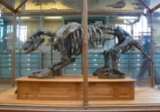
Scelidotherium
Encyclopedia
Scelidotherium is an extinct genus
of actively mobile ground sloth
of the family
Mylodontidae
, endemic to South America
during the middle Pleistocene
epoch. It lived from 780,000—11,000 years ago, existing for approximately .
It is characterized by an elongated, superficially anteater
-like head. In fossil distribution, it is known almost exclusively from Argentina
, but its distribution may have extended into Paraguay
and Uruguay
.
In his journal of The Voyage of the Beagle
, Charles Darwin
reports the finding of a nearly perfect fossil Scelidotherium in Punta Alta
while travelling overland from Bahía Blanca
to Buenos Aires
in 1832. He allied it to the Megatherium
. Owen (1840) recognized the true characters of the remains and named them Scelidotherium, which means "femur beast" to reflect the distinctive proportions of that skeletal element. They were 1.1 metres (3.6 ft) tall and might have weighed up to 6000 lbs.
Genus
In biology, a genus is a low-level taxonomic rank used in the biological classification of living and fossil organisms, which is an example of definition by genus and differentia...
of actively mobile ground sloth
Ground sloth
Ground sloths are a diverse group of extinct sloths, in the mammalian superorder Xenarthra. Their most recent survivors lived in the Antilles, where it has been proposed they may have survived until 1550 CE; however, the youngest AMS radiocarbon date reported is 4190 BP, calibrated to c. 4700 BP...
of the family
Family (biology)
In biological classification, family is* a taxonomic rank. Other well-known ranks are life, domain, kingdom, phylum, class, order, genus, and species, with family fitting between order and genus. As for the other well-known ranks, there is the option of an immediately lower rank, indicated by the...
Mylodontidae
Mylodontidae
Mylodontidae is a family of extinct mammals within the order of Pilosa and suborder Folivora living from approximately 23 mya—11,000 years ago, existing for approximately . This family of ground sloths is related to the other families of extinct ground sloths, being the Megatheriidae, the...
, endemic to South America
South America
South America is a continent situated in the Western Hemisphere, mostly in the Southern Hemisphere, with a relatively small portion in the Northern Hemisphere. The continent is also considered a subcontinent of the Americas. It is bordered on the west by the Pacific Ocean and on the north and east...
during the middle Pleistocene
Pleistocene
The Pleistocene is the epoch from 2,588,000 to 11,700 years BP that spans the world's recent period of repeated glaciations. The name pleistocene is derived from the Greek and ....
epoch. It lived from 780,000—11,000 years ago, existing for approximately .
It is characterized by an elongated, superficially anteater
Anteater
Anteaters, also known as antbear, are the four mammal species of the suborder Vermilingua commonly known for eating ants and termites. Together with the sloths, they compose the order Pilosa...
-like head. In fossil distribution, it is known almost exclusively from Argentina
Argentina
Argentina , officially the Argentine Republic , is the second largest country in South America by land area, after Brazil. It is constituted as a federation of 23 provinces and an autonomous city, Buenos Aires...
, but its distribution may have extended into Paraguay
Paraguay
Paraguay , officially the Republic of Paraguay , is a landlocked country in South America. It is bordered by Argentina to the south and southwest, Brazil to the east and northeast, and Bolivia to the northwest. Paraguay lies on both banks of the Paraguay River, which runs through the center of the...
and Uruguay
Uruguay
Uruguay ,officially the Oriental Republic of Uruguay,sometimes the Eastern Republic of Uruguay; ) is a country in the southeastern part of South America. It is home to some 3.5 million people, of whom 1.8 million live in the capital Montevideo and its metropolitan area...
.
In his journal of The Voyage of the Beagle
The Voyage of the Beagle
The Voyage of the Beagle is a title commonly given to the book written by Charles Darwin and published in 1839 as his Journal and Remarks, bringing him considerable fame and respect...
, Charles Darwin
Charles Darwin
Charles Robert Darwin FRS was an English naturalist. He established that all species of life have descended over time from common ancestry, and proposed the scientific theory that this branching pattern of evolution resulted from a process that he called natural selection.He published his theory...
reports the finding of a nearly perfect fossil Scelidotherium in Punta Alta
Punta Alta
Punta Alta is a city in Argentina, about 20 kilometers southeast of Bahía Blanca. It has a population of 57,296. It is the capital of the Coronel Rosales Partido...
while travelling overland from Bahía Blanca
Bahía Blanca
Bahía Blanca is a city located in the south-west of the province of Buenos Aires, Argentina, by the Atlantic Ocean, and seat of government of Bahía Blanca Partido. It has a population of 274,509 inhabitants according to the...
to Buenos Aires
Buenos Aires
Buenos Aires is the capital and largest city of Argentina, and the second-largest metropolitan area in South America, after São Paulo. It is located on the western shore of the estuary of the Río de la Plata, on the southeastern coast of the South American continent...
in 1832. He allied it to the Megatherium
Megatherium
Megatherium was a genus of elephant-sized ground sloths endemic to Central America and South America that lived from the Pliocene through Pleistocene existing approximately...
. Owen (1840) recognized the true characters of the remains and named them Scelidotherium, which means "femur beast" to reflect the distinctive proportions of that skeletal element. They were 1.1 metres (3.6 ft) tall and might have weighed up to 6000 lbs.

